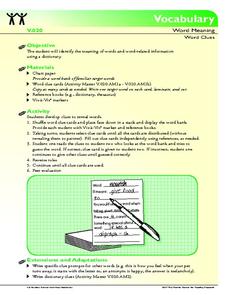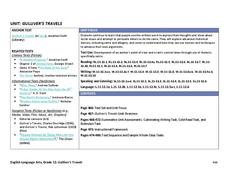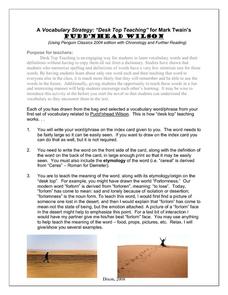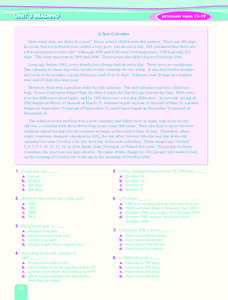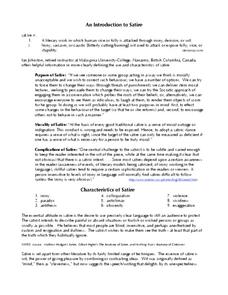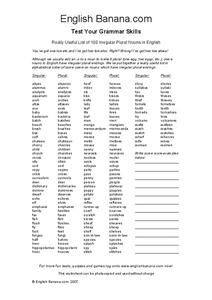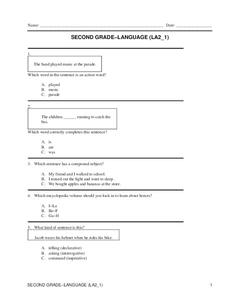Florida Center for Reading Research
Vocabulary: Word Meaning, Word Clues
Young learners develop a deeper understanding of target vocabulary. In pairs, pupils independently complete a series of word clue cards, asking them to find information about key terms, including their definitions, synonyms, antonyms,...
One Pot Learning
Reading Comprehension Worksheet
Three annotated passages from Ralph Waldo Emerson's essay on "Nature" provide young philosophers a chance to improve their reading comprehension skills as they gain insight into Emerson's ideas.
Louisiana Department of Education
Gulliver’s Travels
Gulliver's Travels tells the story of a man who goes on voyages and encounters strange people. A unit plan introduces readers to the classic text, as well as excerpts from other examples of sarcasm and satire, such as "A Modest...
Poetry4kids
Rhythm in Poetry: More Than Two Feet
Want to put some feet in your head? Check out an online lesson about spondees, dactyls, and anapests to bring new structure to your poetic forms.
abcteach
Flowers for Algernon, by Daniel Keyes
Looking for materials to accompany your study of Flowers for Algernon, by Daniel Keyes? Look no further! Included here is everything you need to go alongside your unit: worksheets, graphic organizers, writing assignments, an assessment,...
Florida Center for Reading Research
Comprehension: Text Analysis, Compare and Contrast
Grab any two topics, some index cards, and a couple of kids, and you're ready to compare and contrast! The resource provides instructions for this method and three graphic organizers in addition to or in place of the index cards.
Curated OER
Hoot: Vocabulary Squares
Study the vocabulary from Carl Hiaasen's Hoot with an activity featuring synonyms and antonyms. Kids fill in a graphic organizer for each word, prompting critical thinking as they find additional ways to put the word into context.
Curated OER
The Metamorphosis: Vocabulary Bingo
Franz Kafka's The Metamorphosis is one of the most fascinating pieces of literature from the 20th century, and its rich vocabulary is one of the reasons it has endured for over a century. Help learners of all levels work...
Novelinks
The Tempest: Vocabulary Bingo
Bingo! Practice vocabulary from William Shakespeare's The Tempest with a fun matching game. As you call out the definitions, class members mark the new vocabulary words that match and try to get five in a row.
Southern Nevada Regional Professional Development Program
Vocabulary Activity
Talk about a menu! Who would have thought SAT prep could be so delicious? Treat your class to a full course of SAT words with a timed activity that asks groups to create clues for dishes on their bill of fare. Distained veggies anyone?...
Common Sense Press
The Sign of the Beaver Vocabulary
A series of activities based on Elizabeth George Speare's The Sign of The Beaver takes your class through vocabulary, reading comprehension, and literary analysis. A good packet or collection of assignments for a reading circle.
Curated OER
Pudd'nhead Wilson: Vocabulary Strategy
Invite your pupils to do the teaching when it comes to the vocabulary in Pudd'nhead Wilson. Each individual is assigned one word to research in depth and teach to classmates, one pupil at a time.
Pearson Longman
A New Calendar
The year 1582 was a very strange year. That year there was no October 5, 6, 7, 8, 9, 10, 11, 12, 13, or 14. Kids find out why when they read this short comprehension worksheet with a passage about the new calendar instituted in 1582.
K12 Reader
Christmas Tree Add an Adjective
The star on the top of a Christmas tree can be beautiful, or it can be gold, or it can be shiny—or, in fact, it can be all three! A picture of a decorated Christmas tree encourages pupils to choose from a list of 18 adjectives to...
Jackson School District
An Introduction to Satire
What is satire, and what are its characteristics? A handy handout provides young satirists with all the information they need to analyze a satire or to craft their own.
K12 Reader
Narrative or Expository?
Narrative or expository? That is the question readers face on a two-part comprehension worksheet that asks kids to read a short passage about these two different types of writing, and then to answer a series of comprehension questions...
Houghton Mifflin Harcourt
Silly Stories: Challenge Activities (Theme 1)
This packet, the first in the series of support materials for the Houghton Mifflin Harcourt thematic units on silly stories, contains enrichment activities for learners who have mastered the basic concepts of the lessons.
Teach-nology
Creating Plural Nouns
How to craft the plural form of nouns ending in "y" is the focus of this learning exercise. Following the directions at the top of the page, users provide the plural of the listed nouns in 10 sentences.
Curated OER
Picture Dictionary - Quiz 1
In this picture dictionary worksheet, students read phrases and questions to complete the picture dictionary activity as well as improve their voacbulary skills.
Curated OER
Picture Dictionary - Quiz 3
In this picture dictionary worksheet, students test their vocabulary skills in a picture dictionary vocabulary worksheet. Students answer 20 exercises.
Curated OER
Really Useful List of 100 Irregular Plural Nouns in English
In this irregular plural nouns worksheet, students study the list of 100 common irregular plural nouns. Students also add their own examples of irregular plural nouns that are not listed on the chart.
Curated OER
Guide Word Practice
In this guide words worksheet, students learn how to use guide words in the dictionary when looking for a word. Students circle the words that could be found on the page with the three examples of guide words. Then, students rewrite the...
Curated OER
Second Grade Language
In this language arts activity, 2nd graders complete fill in the blank and multiple choice activities about subjects, pronouns, dictionary work, and more. Students complete 25 questions.
Curated OER
Really Useful List of 100 Plural Nouns in English
In this language arts worksheet, students analyze a list of 100 nouns which do not follow the usual rule of adding an -s to make a plural. Students fill in the blanks of the chart and make irregular plurals. Example: tooth (teeth).


